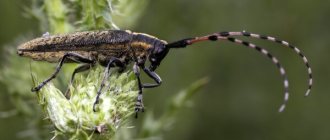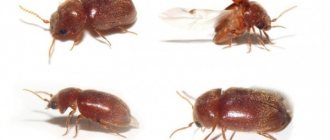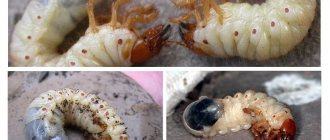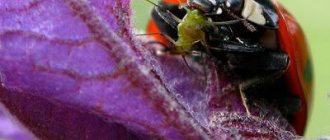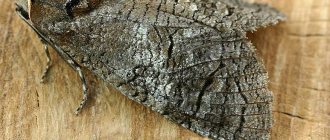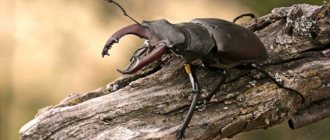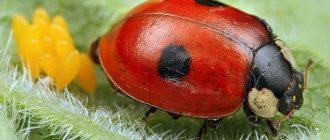Description and features
These insects are mostly harmless in themselves; they feed on plants, mainly of the woody variety. But sometimes they look very menacing. The most striking feature is the long mobile whiskers, their size is 2 or even 5 times the length of the body. At the base of the antennae are the insect's eyes. The mustache is an organ of smell and touch.
What all these beetles have in common is an elongated body structure, although, depending on the species, the shape itself can be wider at the sides and more elongated. The body structure of adult individuals can be divided into three main parts: head, chest and belly. The limbs are divided into 5 components - pelvis, trochanter, femur, tibia and tarsus.
They have 3 pairs of legs, hard chitinous elytra, and some have large jaws. The abdomen is soft, divided into segments, most often into five. Their head is round in shape and sometimes fits quite tightly into the prothorax.
Males differ from females by having longer mustaches, the upper jaws of males are also more developed, the abdomen is sharper, and they are often painted a different color. Their body shape is more flattened and wider. These beetles are characterized by such a concept as sexual dimorphism. This is when females and males look different, as if from different species.
Many longhorned beetles make sharp sounds, such as squeaking or grinding sounds. This occurs due to friction of the prothorax rib against the rough surface of the mesothorax, or friction of the thighs of the hind legs against the elytra. They make such sounds when there is a threat of attack from enemies. Most likely to scare them away.
Their coloring varies greatly. It consists of the color of chitinous wings and hairs on the body. The colors delight with their diversity. Light shades - creamy yellow, salad, lemon, pink.
Dark shades - brown, purple, black. Combined coloring is very common - stripes, spots and other patterns, sometimes of a complex and ornate shape. All external differences between beetles depend on their habitat and species affiliation.
Gray long-whiskered beetle – coniferous forest orderly
You may encounter a gray long-whiskered beetle at your dacha, if, of course, the dacha is located on the edge of a coniferous forest.
Most of all, this beetle prefers pine forest or mixed forest with a predominance of Scots pine. It is on fallen pine trunks or stumps that you can most often see this colorful insect, shown in the following photo.
As you can see in the picture, the long-horned beetle is actually both gray and long-haired, so the beetle fully lives up to its name.
Place in classification and description
The gray long-horned beetle belongs to the genus Acanthocinus of the Long-horned family. This insect, 1.5-2.5 centimeters long, has antennae, which are appendages that are several times the size of the body: in females by 2-2.5 times, in males by 5. There is obvious sexual dimorphism.
Our help! Sexual dimorphism is a pronounced external difference in insects of different sexes.
The beetle's antennae are colored to match a police baton or barrier: black stripes alternate with gray ones.
The beetle's body color is gray, as its name suggests. Specks of a darker shade are distributed throughout the chitinous cover, and on the head there are four orange dots, visible under high magnification.
Habitat and feeding habits
The beetle's habitat is quite wide - almost all of Eurasia. The main habitat is coniferous and mixed forests, mainly where there is a lot of pine. In its absence, the gray long-horned beetle can settle on many other types of trees, not only coniferous, but also deciduous.
Despite their love for pine, longhorned beetles are not dangerous pests, because they prefer to settle on dying wood:
- stumps;
- fallen trees;
- windbreak;
- rotting wood.
At the same time, beetles and their larvae feed exclusively on bark and bast, without affecting the wood itself and without causing damage to it
This is especially important when colonizing a living, strong tree with longhorn beetles.
In addition, sawdust produced when barbels feed fill the space under the bark and thus prevent other insects and their larvae from entering the tree. From this point of view, the gray long-horned beetle is a protector insect.
Our help! The main pest of longhorned beetles is the common woodpecker. It is this hardworking bird that eagerly picks out larvae from under the pine bark.
Reproduction and insect development cycles
The gray long-horned beetle is an insect with a full generation cycle. This means that it goes through four stages of development:
- egg;
- larva;
- chrysalis;
- imago.
The beetle goes through all stages within one year; the longhorned beetle does not have two generations. There are even years in which the complete transformation does not have time to occur and the pupae, or even larvae, disappear before winter.
Beetles begin to reproduce in May, when the air temperature in the forest rises to 10-15 degrees Celsius.
Mating occurs in an open space, after which the female looks for a secluded place in the wood: cracks, chips, old insect passages.
Attention! Look how in the previous photo you can see the difference in the length of the antennae of the male and female. Soon, small white larvae emerge from the testicles and immediately begin to feed, quickly gaining height and weight
The body of the translucent caterpillar is covered with small hairs, and its front part is wider than the tail.
Soon, small white larvae emerge from the testicles and immediately begin to feed, quickly gaining height and weight. The body of the translucent caterpillar is covered with small hairs, and its front part is wider than the tail.
Around mid-July, the caterpillars reach their maximum growth and begin to pupate. This stage of development lasts for a couple of weeks, and in August adult insects appear. However, as mentioned above, in case of bad weather conditions, this cycle may extend to next spring.
Benefit or harm?
Above in the text we have already analyzed the influence of the gray long-horned beetle on nature, now it’s time to summarize what has been said.
Undoubtedly, from the point of view of a pine tree, an insect that eats wood tissue is undoubtedly a pest. However, there are two serious counterarguments to this:
- Insects feed mainly on dying trees and do not affect the wood.
- The waste products of longhorn beetles and their larvae prevent damage to wood by other pests.
Conclusion: the gray long-horned beetle is a beneficial insect!
To sum up what has been said, a video from the girl Katya will help us, in which she collected the coolest pictures of a beetle in its various stages of development.
Kinds
Very rough estimates indicate about 26,000 species of these creatures, but these data often change. Almost every year new species are discovered from different places, mainly from the tropics and areas close to the equator. However, new species also appear in civilized Europe, exotic Asia and advanced America.
There are 583 species of them on the territory of Russia. Despite their diversity and abundance, these insects have been well studied by scientists. Most are average in size for beetles. But there are also giants among them. For example, the titan lumberjack, which lives in North America, reaches 19-22 cm in length.
There is another large species in South America - the Brazilian bigtooth woodcutter, the size of which can be 17-18 cm. The longhorned beetle from Fiji is the third largest of the large beetles known at the moment. Its size reaches 15 cm.
Lumberjack bigtooth
Of the European beetles, the largest at the moment is the carpenter's longhorned beetle, it is about 6 cm long. Russia also has a large representative of this species - the Ussuri relict longhorned beetle. He grew to 11 cm.
Relict barbel
There are 11 subfamilies belonging to the barbels. Let's talk about some of them. Their names: true longhorned beetles, laminae, longhorned beetles, parandrins, prionine longhorned beetles, spondylidins. Lamiinae include more than 13,000 species of beetles, many of which look elegant in appearance. For example, some have transverse stripes of black and greenish color along their wings.
Prionins include 1000 species. This is one of the oldest beetles. Found everywhere on earth except cold polar regions. The size varies greatly, from 2 mm to 178 mm, but mostly these are large beetles, sometimes even up to 22 cm.
Painted in brown, black, brown tones. It is to this subfamily that the giants among beetles belong: the titan woodcutter, the Brazilian bigtooth woodcutter and the Ussuri relic woodcutter.
Parandrins number 50 species and live in the tropics and subtropics. They are atypical for the family, as they have very short antennae, which are more reminiscent of staghorns. The color of their hard wings is usually red-brown or black.
The barbels or lepturines are a family of 100 genera and 2500 species. Small beetles, the wings are colored with yellow and black stripes.
Spondylidins include more than 100 species. These are nocturnal and crepuscular representatives. Their whiskers are also not very long, their size is smaller than their body. The color of the wings is blue-black or black-brown.
This longhorned beetle in the photo resembles a picture from Egyptian frescoes. It is very beautifully outlined, there is an interception in the middle of the body, the wings have a noble matte tint, a little like a bronze vase. The whiskers are segmented, the paws are very elegant. Just a model for a coat of arms.
Lifestyle and habitat
The longhorned beetle lives throughout the planet where there are forests. Their distribution depends on the availability of food - mainly trees. The exceptions are the Arctic and Antarctic, precisely because of the lack of food supply.
They are quite active in their lifestyle. They crawl, many very quickly. Some of them can fly. If you pick up a beetle, it makes a characteristic chirping sound. Their lifestyle depends on the climate and habitat.
In the southern regions, these insects “take wing” from mid-spring. Central Asian beetles begin to fly closer to autumn. Some are active during the day, feeding mainly on flowers that open during the day. Others are active at night. Their food does not hide in the dark.
Both nocturnal and daytime beetles find hard-to-reach places to rest or mate. Depending on the size, the flight range is determined. The larger the beetle, the less it flies and the more it crawls. They lead a very secretive lifestyle. Seeing an adult beetle in the forest is a real gift for an entomologist and an alarming signal for a forester.
Nutrition
What the longhorned beetle eats depends on its habitat. Adult beetles feed on pistils and stamens of flowers, young bark and leaves of bushes and trees. Pieces of fallen or healthy bark, petioles, plant sap, pulp of cacti or other plants - this is what the longhorned beetle feeds on.
That is, an adult beetle is almost harmless. But the larva of the longhorned beetle is a scourge for trees, wooden buildings and wooden objects. They develop in trees and feed on wood, causing enormous harm to forests on the planet.
Many beetles were divided into subspecies precisely due to the choice of the type of tree they chose to feed their larvae. For example, the oak longhorned beetle prefers hardwood trees, oak, for example.
It can settle in oak stumps, as well as in places where the tree is damaged. This beetle is medium in size, 3 to 6 cm, black with a brown tint, and glossy like resin. The elytra are reddish at the tips. In addition to oak, he chooses beech, hornbeam, elm, and walnut for feeding future larvae.
The black or pine longhorned beetle prefers to choose coniferous trees. It is also called the ship beetle. Its larva inexorably destroyed even ready-made ship structures if they were built from infected pine. He himself feeds on pollen, pine needles and leaves.
The beetles that prefer coniferous trees for their clutches - larch, spruce, pine, also include the flat beetle, with a purple color.
The purple longhorned beetle itself feeds on the soft bark of young trees and tender young needles. But its larva causes damage to trees on an almost industrial scale. They continue to destroy wood, even harvested and cut for consumption. They also love to live close to humans, destroying buildings.
Gray long-whiskered beetle
Insect antennae are appendages that are similar in origin to the limbs of ancient primitive arthropods. And although the function of these formations is generally the same for all representatives of the class (they play the role of sensory organs), their shape and size vary widely. There are insects with incredibly long antennae, such as beetles of the longhorned beetle family. In one of the species they are so large that this feature is reflected twice in the name - gray long-whiskered barbel. The tautology used is absolutely justified: female beetles have antennae twice as long as their bodies, and males have antennae that are as much as five times longer!
What does it look like
As the name of the species suggests, the body of the longhorned beetle is colored gray. The surface of the elytra is granular. The long antennae are covered with many hairs, and because of their coloring - alternating light and dark stripes - they look like a traffic controller's baton.
This insect lives in Europe and Asia.
Lifestyle
The favorite tree of the gray long-horned beetle is pine; it is on this tree that this beetle can be found most often. In addition, another 25 species of not only coniferous, but also deciduous trees can be a haven for the insect.
The development of larvae is usually rapid. The breeding season lasts from May to August, and already in the fall, in small cells gnawed under the bark, a new generation of longhorned beetles can be found. But it happens that the larvae overwinter, and then the adults appear only in the spring.
Due to the camouflage coloration, it is not easy to notice the gray long-horned beetle on a tree
Harm or benefit?
Like many other beetles, the larvae of the gray long-horned beetle live in wood. However, unlike the larvae of a whole galaxy of bark beetles, borers and grinders, they are not pests at all. This is because preference is given not to healthy and strong trees, but to fallen trunks and stumps. In addition, barbel larvae gnaw their tunnels mainly in bark and bast, while the wood remains intact.
Scientists also noticed that this long-whiskered insect not only does not spoil trees, but even saves them from real parasites: when the beetle population is large, its larvae almost completely clog the space under the bark with a thick layer of compressed sawdust. Pests are unable to overcome the barrier - and the tree remains clean.
Classification
Superclass: Insects (Insecta) Class: Open-jawed (Ectognatha) Order: Coleoptera (Coleoptera) Family: beetles (Cerambycidae) Genus: Acanthocinus (Acanthocinus) Species: Gray long-horned long-horned beetle (Acanthocinus aedilis; Linnaeus, 1758)
Reproduction and lifespan
The entire breeding process takes place in a quiet and calm place, somewhere higher. On the top of a tree, on the roof. Females secrete a special fluid (secret) that attracts a partner. Mating takes about 30 minutes. The female who has received attention remains under the protection and supervision of the male, who accompanies her until the eggs appear.
At the end of the mating season, the male dies, and the female survives it to lay eggs. The female beetle lays up to 100 eggs in cracks in trees and wood parts. She chooses the laying site by smell. Having created a clutch, the insect no longer shows any concern for the offspring.
Larvae emerge from the eggs, then pupae, and only after a few years do they eat through the passages in the tree and crawl out. The larvae themselves, growing, almost reach the length of an adult beetle. The entire life cycle consists of several stages: egg, larva, pupa, adult.
Sometimes longhorned beetles prepare in advance a place for feeding and development of future larvae. They choose small trees and eat the bark around the perimeter in the form of a ring, closer to the root. As a result, the tree begins to slowly die. And the deposited larvae complete the destructive process.
They make a loud crunching sound as they bite into the wood. Sometimes in a dry forest you can even hear this characteristic sound. The larvae are very hardy. They tolerate any unfavorable conditions and live in dry and nutrient-poor trees for many years.
They have a light body color, from white to yellowish. The body itself is soft, slightly flattened, with a well-developed cephalothorax. It is equipped with powerful jaws directed straight forward, which can perform both cutting and chewing functions.
The life cycle of an adult is quite short. The beetle emerges from the pupa in early spring, although for this the larva must have time to “pupate”. If spring is far away, the pupa burrows into the core of the tree and hibernates, waiting for the onset of warmth.
Insect biology
Place in classification and description
The gray long-horned beetle belongs to the genus Acanthocinus of the Long-horned family. This insect, 1.5-2.5 centimeters long, has antennae, which are appendages that are several times the size of the body: in females by 2-2.5 times, in males by 5. There is obvious sexual dimorphism.
Our help! Sexual dimorphism is a pronounced external difference in insects of different sexes.
The beetle's antennae are colored to match a police baton or barrier: black stripes alternate with gray ones.
The beetle's body color is gray, as its name suggests. Specks of a darker shade are distributed throughout the chitinous cover, and on the head there are four orange dots, visible under high magnification.
Habitat and feeding habits
The beetle's habitat is quite wide - almost all of Eurasia. The main habitat is coniferous and mixed forests, mainly where there is a lot of pine. In its absence, the gray long-horned beetle can settle on many other types of trees, not only coniferous, but also deciduous.
Despite their love for pine, longhorned beetles are not dangerous pests, because they prefer to settle on dying wood:
- stumps;
- fallen trees;
- windbreak;
- rotting wood.
At the same time, the beetles and their larvae feed exclusively on bark and bast, without affecting the wood itself and without causing damage to it. This is especially important when barbels colonize a living, strong tree.
In addition, sawdust produced when barbels feed fill the space under the bark and thus prevent other insects and their larvae from entering the tree. From this point of view, the gray long-horned beetle is a protector insect.
Our help! The main pest of longhorned beetles is the common woodpecker. It is this hardworking bird that eagerly picks out larvae from under the pine bark.
Reproduction and insect development cycles
The gray long-horned beetle is an insect with a full generation cycle. This means that it goes through four stages of development:
- egg;
- larva;
- chrysalis;
- imago.
The beetle goes through all stages within one year; the longhorned beetle does not have two generations. There are even years in which the complete transformation does not have time to occur and the pupae, or even larvae, disappear before winter.
Beetles begin to reproduce in May, when the air temperature in the forest rises to 10-15 degrees Celsius. Mating occurs in an open space, after which the female looks for a secluded place in the wood: cracks, chips, old insect passages.
Attention! Look how in the previous photo you can see the difference in the length of the antennae of the male and female.
Soon, small white larvae emerge from the testicles and immediately begin to feed, quickly gaining height and weight. The body of the translucent caterpillar is covered with small hairs, and its front part is wider than the tail.
Around mid-July, the caterpillars reach their maximum growth and begin to pupate. This stage of development lasts for a couple of weeks, and in August adult insects appear. However, as mentioned above, in case of bad weather conditions, this cycle may extend to next spring.
Benefits and harms for humans
When the larva gets out, a hole is formed in the tree, from which small sawdust spills out. This way it becomes clear where this harmful beetle lives. Sometimes they eat the tree from the inside until it is completely rotten, and it collapses.
Some beetles, such as the house beetle, have become unpleasant neighbors for humans. They are rare in nature, but they thrive in wooden houses. The home's upholstery, floors, wood window frames, ceiling rafters and roof can all be damaged if this insect infests. They lay larvae that destroy anything wooden.
Even furniture, beds, tables and chairs, may suffer from such proximity. Beetles prudently lay eggs in hard-to-reach places - deep cracks in wooden products. After 2 weeks, larvae emerge from them, which begin their invisible destructive activities. If these items are not processed in time, after a while everything will turn into dust.
There are, however, individuals of the woodcutter beetle that are not dangerous, but, on the contrary, are beneficial. For example, the gray longhorned beetle is not so harmful to the forest. It only affects old and dying trees, which speeds up the transition of loose wood into humus. Many beetles act as pollinators of flowering plants, providing more benefits than classical pollinators.
How to get rid of barbel
The longhorned beetle at home is one of the most terrible enemies of man, if not the most dangerous. Its larvae are hardy, voracious, and are not immediately detected. Therefore, you need to know some rules on how to get rid of the longhorned beetle so as not to be left homeless.
- When choosing wood, be sure to check whether it has been treated with an antiseptic.
- When constructing a building, use special finishing products for wood with an antiseptic. They will prevent bugs from invading.
- If you have bugs, be sure to carry out emergency treatment with chemicals. These are bromomethyl, zinc chloride, sublimate. Moreover, such treatment must be carried out 2-3 times a year. The larvae are tenacious, and prevention is a must. It is important to remember that the process must be carried out under the control of the relevant services. It is better to call specialists from the sanitary and epidemiological station for this purpose.
You should also contact specialists if you decide to fumigate against beetles, treat with poisonous gas, or install poisonous baits. All these methods require a careful professional approach.
You can treat it with dry steam or, conversely, by freezing. Only these methods are difficult to implement at home. And they are not safe. Therefore, they are used in production, and only in strictly designated places.
A modern method of getting rid of house beetles is microwave irradiation. A special device heats the wood even in hard-to-reach places, destroying the larvae. The advantage of this method is safety for people and buildings. It happens that some affected parts are easier to cut out and replace with new, undamaged and treated ones.
How to get rid of longhorned beetle using chemicals
If longhorned beetles are found in the house, you need to immediately take measures to destroy them. In order for wood to last as long as possible, it must be processed before building a house. As a rule, they use a fumigation method based on phosphine gas. If the tree has not been treated, then beetles will definitely appear. Then you will have to do a series of actions.
For example:
- First of all, it is necessary to check the extent of damage to the wood. To do this, take a screwdriver and use it to pierce the wooden structures. If the tool easily fits into the wood, then it is better to replace such structures.
- Those structures that the beetle has not yet reached must be treated with special liquids. Before this, wooden structures are cleaned with a wire brush, after which all dust and sawdust must be removed with a vacuum cleaner. After this, the surfaces are treated with an insecticide. Before this, everyone living in the home is evacuated and the windows and doors are tightly closed.
- In cases of severe infection, syringing is carried out. To do this, holes are drilled in the wood with a thin drill, in increments of 3 cm, and an insecticidal solution is injected into them using a syringe.
There are many products available on the chemical control market to kill all types of insects. In such cases, it is better to choose liquids, since they can penetrate the wood structure and destroy the larvae there.
What types of insecticides are there:
- Contact action. Insects and their larvae die upon contact with the chemical. These products are rarely used, since working with them can cause poisoning.
- Intestinal action. If it enters the intestines of an insect or larva, the substance leads to death. Based on such components, baits are made, which include an insecticide and an aromatic substance to attract insects.
- Fumigants. They emit gases that are toxic to insects.
You can use the following against longhorned beetles:
- Empire-20.
- Tree healer.
- Antibug.
- Antishashelin.
Rules for the use of insecticides
When using insecticides, you must adhere to a number of rules. For example:
- Residual agents are applied to surfaces using spray guns. These substances are practically safe for people and pets, so you can return to the room within a few hours after treatment.
- To treat hard-to-reach places, a different method is used. To do this, holes are drilled and a toxic substance is supplied through a thin tube to the problem area. After this, the hole is filled with wax or paraffin. After some time, the wood will be saturated with the product and the larvae will die. This treatment requires leaving the premises for several days.
- If the walls are made of thick logs, then it is better to use a product such as Lignofix I-Profi. A hole is drilled in each beam, every 5 cm from top to bottom or vice versa. The distance between the rows is up to 1 m. Then a syringe is taken and insecticide is applied to each hole. After some time, when the product is absorbed into the wood, the operation should be carried out a couple more times. After completion of the procedure, the holes are sealed with sealant.
- When buying a remedy for longhorned beetles, you need to make sure that the product will help, since it is intended specifically for such purposes.
Interesting Facts
- Despite its powerful jaws, capable of chewing through a pencil, the beetle's bite is not dangerous to humans. He is not capable of causing him serious harm.
- An adult longhorned beetle, even a giant one, eats very little. Sometimes he lives only thanks to the reserves that he accumulated as a larva. Females feed more than males to ensure normal egg maturation.
- In her territory, the female most often has no rivals. She secretes a special pheromone that attracts males and repels other females.
- A grown beetle lives for one summer season, a maximum of 2-3 months, and the larva is much longer, for years, in some species up to 10 years.
- Some futurists predict that in the future we will eat wood. If you study and use the digestive system of the longhorned beetle, it is quite possible to do this. Its intestines are equipped with special bacteria that process cellulose into easily digestible carbohydrates. Periodically, the larvae process these bacteria, obtaining additional nutrients from them. Waste-free production.
- It may seem strange, but not butterflies and bees, but the longhorned beetle is inextricably linked with flowering plants. They spend most of their short lives on flowers. And because of their size, they pollinate a large surface. Thanks to his taste preferences, some plants have been preserved and survived in nature.
Features of life and development of the long-whiskered gray barbel
In addition to being known as the gray long-horned beetle, the beetle has been given different names over the years: Cerambyx acernus (aka C. marmoratus, also known as C. aedelis) and Aedelis montana; at the moment, the scientific classification has approved the name Acanthocinus aedilis.
Insect Form
The body shape of male and female insects is practically the same - they differ only in size, ranging from 12 to 20 mm.
Male beetle Acanthocinus aedilis
Males are much smaller than females, although the length of their mustache in relation to the total body length is comparable to that of the sorcerer Chernomor from “Ruslan and Lyudmila” (the ratio can reach 1:5).
Another noticeable difference by which a female insect can be recognized is the conically tapering flat extension of the rear part - the ovipositor.
Body shape of a female gray long-horned beetle
The coloring of the upper half of the body of both sexes makes it possible to notice insects only when they move along the bark of trees, which they examine for suitability for life.
For the most part these are coniferous trees:
- pine;
- fir;
- larch;
- spruce.
The body coloring of the longhorned beetle consists of gray-black-brown specks and small spots.
The obligatory “trademark” of the insect is the presence on the pronotum (pronotum) of four orange-red spots arranged in a row.
In addition to being most often found on spruce trees, where it is best able to camouflage itself with the color of the bark, the longhorned beetle can also be found on deciduous trees.
Adult Acanthocinus aedilis beetle on tree bark
This is most often maple, hence the Latin species adjective in the synonym for the name: acernus - meaning maple. Another adjective: marmoratus (marble) conveys the body color of the described representative of the family of woodcutter beetles no less successfully.
You can also read our article: Sky barbel, photo and lifestyle of a magnificent insect
Why “woodcutter”, or about insect nutrition
For all its romanticism, the name “woodcutter” does not reflect the essence of the insect’s lifestyle. Its discovery on fallen trees seems to indicate that they are “filled up” with it.
Head of a gray long-whiskered beetle
Yes, the gray long-whiskered beetle feeds on plant foods, but of a completely different quality:
- pollen;
- needles (leaves);
- juice flowing from cracks in the bark.
Young beetles need nutrition for the final maturation of the reproductive system in order to leave behind strong offspring.
About the life cycle of an insect, or about daily and seasonal activity
The flight of beetles begins with a stable warming in April-May and ends with a cold snap in September.
Acanthocinus aedilis beetles mating
The beetles that have reached maturity mate, after which the females, using their long hard ovipositors, lay eggs (from 30 to 50) under the bark of trees, which become food for the hatching larvae.
The choice of places for laying eggs by a fertilized female is made very carefully.
Gray long-horned beetle larva
The wood of living and healthy trunks and branches is not suitable for feeding the larvae - despite the powerful jaws, the larvae can only handle fibers from trees that are already dead or at the dying stage.
As the body grows and its mass increases (and in connection with the onset of the cold season), insect larvae from the spaces under the bark slowly move deep into the tree trunk, where, upon reaching full development (about 35 mm in length), they pupate.
Gray long-horned beetle pupa
Young males and females emerging from pupae in the spring gnaw through the bark of the food tree - a new circle of life begins with difficult, reluctant flights, carried out mainly in the evenings (exclusively for feeding and mating) and waiting out the heat of the sun in secluded places during the daytime.

